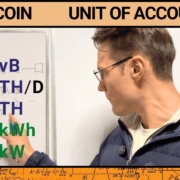Hyper-Decentralisation: Will Public Bitcoin Miners COLLAPSE? | Hashpower Academy
Hyper-Decentralisation: Will Public Bitcoin Miners COLLAPSE?
Are public Bitcoin miners doomed? These profit-driven giants—like Marathon and Riot—buy power cheap, sell BTC high, chasing efficiency to stay alive. But what happens when margins vanish? In this video, we uncover how the game flips: older ASICs switch from a profit to a focus on heat output, offsetting energy bills with Bitcoin as a bonus. Hashrate heating turns miners into home heaters, laundry dryers, and greenhouse boosters—a Trojan horse for hyper-decentralisation. Every house could “read, write, own” BTC—disrupting Wall St and miners alike! Could this collapse the big players and spark a decentralized revolution? Watch to find out!
Financial Disclaimer:
This video serves educational and informational purposes only and should not be construed as financial advice or investment recommendation. The views expressed are those of the presenter and do not represent Hashpower Academy’s official stance. Information is provided ‘as is’ without warranties, express or implied, as to its accuracy or completeness. Engaging with Bitcoin involves high risk, including potential financial loss, market volatility, and energy costs, and is suitable only for those who can bear these risks. Always conduct your own research and consult with a qualified financial or technical advisor before making decisions related to Bitcoin.
#Bitcoin
#BitcoinMining
#PublicMiners
#HyperDecentralisation
#HashrateHeating
#Crypto
#MiningCollapse
#MarathonDigital
#RiotBlockchain
#MicroStrategy
#Finance
#WallStreet
#CryptoMining
#HeatingSystems
#HVAC
#Engineers
#Decentralized
#BitcoinFuture
#CryptoInvesting
#EnergyInnovation
Video Transcript:
hello there and welcome to the Hashpower Academy My name is Jake Scandlin I’m the lead educator here at the academy and this is a place for you to learn anything to do with Bitcoin and everything to do with Bitcoin Starting with the fundamentals and those fundamentals are to do with the energy side of things the compute Bitcoin mining aspects and Bitcoin taught in the context of money finance and the blockchain taught last And when you go through the layers like that you have a more grounded understanding of the production process essentially of Bitcoin And who sits in the middle of that epicenter well it’s the Bitcoin miners And the topic of today’s video is hyper decentralization and potentially the collapse of the publicly listed Bitcoin miners Why the short-term answer is that Bitcoin mining is a a game of efficiency and energy availability Those are the two levers You’ve got the uptime of the machines and the performance and the ability to repair and the access to chips and all these sorts of other pieces But the two key uh metrics across all of the Bitcoin miners are what is the efficiency of their mining hardware and essentially how many blocks of Bitcoin are they capturing relative to the network what is the profitability of mining if the the dollarized price was to shoot up to really high levels and production stays low well you’re capturing a large premium of dollarized value of quantity of Bitcoin But in the bare market when price is trading closer to production you’ve really got to be efficient to survive And the whole approach here of why I believe hyper decentralization will naturally occur is this So I’m going to first explain uh just the dynamics of efficiency and from that you’ll understand the the context of hyper decentralization because it will occur when uh well Bitcoin mining compute chips are pretty much in every home and potentially a node in every home And so if you’ve got a storage system of data on top of that the three core components of read write and own would be essentially in the home how how much more decentralized can you get from that and this will occur from the world of being able to source power so potentially uh local electricity grid or producing energy yourself being able to convert some of that excess energy into compute hash power and that allows you to earn Bitcoin um through blocks to store that transaction data in your own node and your own wallet So uh I do believe that in the future someone somewhere will make a device that reintegrates all of the core components of the entire Bitcoin network the six core pieces and the three core commodities of electricity comput and Bitcoin all in a single device for the home And that will bring us to hypers decentralization Big word And the path there is truly through efficiency And let me explain why The Bitcoin miners at large industrial scale they get the economics of buying a machine at potentially half the price that you would pay at retail Now why is that important well if you spent $5,000 on one machine you’ve got one machine $5,000 and you’re now pricing that $5,000 of dollars or that quantity of Bitcoin that you paid against the potential for that single machine to produce Bitcoin We don’t even need to know the amount The point is if a large industrial scale miner can buy thousands of that same computer but at half the price he spent half the bitcoin but gets that same amount of bitcoin from that machine relative to production of compute and uptime So if he spends half the amount his his uh the rate of the quantity of bitcoin he needs to accumulate to break evenffect effectively in dollar or bitcoin terms is half the half the amount And as more time goes on the le you you earn less Bitcoin over time because it’s fewer Bitcoin being chased by more energy or dollars in that sense And so efficiency is critical for this because efficiency changes that metric of how much electrical it cost in versus Bitcoin out And so that continual purchase of new machines and they’re at higher prices Think of the latest generation iPhone The latest generation iPhone is really expensive but if you jump back five 10 generations they’re really cheap And the difference between those different generations of iPhone are the the density of transition transistors in the microchip the storage and the the processing um and features and whatever else they actually don’t put in iPhones anymore I used to be excited about the latest one coming out with new things but now it’s the same thing There’s there’s uh it’s flattened out there’s no prosperity there But here with Bitcoin mining if you bring out a new more efficient chip you now earn more Bitcoin because there’s less cost associated to the the conversion rate For example if you buy a really old machine of last generation 30 jewels of energy per terash Now you can multiply jewels and terraash by a million to change it to essentially u megawws and exahash So I have here um these figures effectively multiplied by a million but it’s the same conversion rate 23.5 it would be 23.5 megaww per xahash So I have it in an xahash figure but you can s you can use the same the same uh variable So 30 jewels per terahash um well that’s the same as saying 30 megawws per xahash and one xahash is making.56 bitcoin So um all of these comput all these three examples produce well in this a terraash but it can be an exaash So all these three computers produce $47,000 worth of bitcoin but they have three different types of electrical cost 30 megawatt 20 megawatt and 10 megawatt at 5 cent a kilowatt I know I’ve been moving all the units around but the gist is this Um the 10 jewels per terahash most efficient most expensive computer has a electrical bill of $12,000 a day versus the $47,000 of mind All three mine the same amount but have but this one being 20 jewels instead of 10 is twice as much electrical billing or three times as much electrical billing So it’s the the hash rate produces the same amount of uh the same fungeable amount of compute makes the same fungeible amount of um bitcoin and underneath the energy is changing because of efficiency and the least efficient machines are cheaper and you get this process of miners are effectively buying buying efficiency in bulk They average across all the different groups They are mining and they’re getting rid of the older more inefficient compute uh cell Now 5 cent is a very generous rate for um larger more infrastructure scale miners But let’s say residential 15 15 cent per kilowatt So you would multiply this by three which barely makes you break even You multiply this by three and you’re making a loss You multiply this by three you’re making even more of a loss And that’s the reason why as as the as time goes on the Bitcoin network is gaining more efficiency The average approximately of the network is 22 23 But as time goes on the entire pole of compute that is producing the next block in the chain is getting more efficient over time Meaning it’s a lower jewels per terahash figure and also the pricing system of those computers What happens to all the old machines what happens well the value of a computer um to produce say an electrical bill of right now say $12,000 of electrical bill to earn you $47,000 a bitcoin That’s buy low in energy sell high in Bitcoin And that is a business that generates a margin of profit and that profit cycles back into paying that machine But the overall approach of a large scale industrial miner is to make a profit Now if the electrical bill was to treble here up to 90kish or even 100 plus um versus the $47,000 worth of Bitcoin uh for every $1 of electrical spend you’re earning 50 cents of Bitcoin So the value of that machine changes The value of old less inefficient machines change from producing Bitcoin into producing heat And the heat is a subsidy because some of that heat the heat is produced Energy is neither created nor destroyed If a kilowatt of electricity goes into your computer a kilowatt of electricity comes out as as wasted heat And um yeah the value of old more inefficient cheaper chips are that they produce heat And some of that cost is subsidized because even if even if you can recoup a percentage of that electrical bill in Bitcoin because you are producing some compute power it gives a value for those old machines And so that’s what we’re going to see is um heating systems Now where do you put heating systems over half of our uh global need for energy is to produce heat And that can be in your house That could be part of your boiler system That could be uh your business of running a a laundroet You need a big large tank of hot water to to run those pipes off to the different washing machines when it needs hot water You got paying customers and it there you go as a business idea um any any business that needs heat there is ways of understanding if the economics of the cheaper less inefficient machines can subsidize some of that energy cost for that demand for heat and economically pay back some of that heat as a subsidy You’re not spending you know $100 a month on energy to make more than $100 a month in Bitcoin Maybe when there’s a really heavy bull market you’re going to earn well but it’s about combining that computer in a heating system that is part of a different other revenue stream And so what this does is you have one energy input but two energy outputs If if a farmer uses some form of heat source to stabilize the temperatures in green houses like right now it’s spring uh the fear in spring is that you you you put the seeds into the soil they start growing the shoots and then a frost comes It gets all cold and kills everything off Would the farmer justify building green houses and stabilizing the the temperatures of those green houses with heat it’s too expensive But maybe there’s a path to generate heat from compute from Bitcoin mining So now he can grow crops to their optimal or even improved yields with warmer temperatures around them and a secondary digital income stream from Bitcoin mining Now what does that do that allows for the potential of hyper decentralization the expansion of compute power into every home add on top some uh very small chips that store terabytes of data and maybe even a potential potentially part of a power system I see a path in which the old less inefficient chips from Bitcoin mining um disperse into the world and if it happens at volume and we’ve discussed in other um uh episodes shall we say on this channel that if more compute chases fewer Bitcoin um the amount of Bitcoin per kilowatt hour drops Now a public miner is a forprofit buy energy low sell it high as Bitcoin If the Bitcoin per kilowatt were to collapse because more and more compute is joining that is not mining in an economic sense Remember buy energy low sell Bitcoin high If that profit margin collapses all of the public scale industrial miners will have to think and restrategize into exploring other forms of um combining their business with other services Yes demand response of selling and buying power to stabilize the grid That’s one heating systems with the computers But the problem with that is uh a site producing several megawws of power consuming several megawatts of power is producing several megawatts of heat You don’t need that much heat in one particular location It has to be more decentralized And so the systematic inevitability of uh ASIC design the the specific computers is getting smaller It’s going as small as a single chip down to the Bit Axe mini miner level but it’s also that’s just a single chip Um and it’s also being you know say uh half a kilowatt to a kilowatt So an electric heater in your house Um even with um the renewables side of things the carbon accounting so producing um uh electricity off-rid on an old oil well with the gas still leaking out So they have to burn it They have to burn it So capture that energy and and turn it into electricity and generate carbon credits as well So there’s all these other physical attributes of Bitcoin’s network which will generate secondary revenue streams but you can’t concentrate or should we say centralize all of those computers in one place because it limits your ability to create heating systems Um there’s other design ideas I have related to yes like oil uh like pipelines for oil that the temperature slows down the the rate of oil transfer Maybe you could run microchips along the uh the oil pipes and and sustain some warm temperature so allow the the fluids to flow more uh well flow easier There’s there’s several different things and especially on the compute side of things If you’ve got this path of design where we could potentially see the network hash rate massively increase not because large industrial scale miners are deploying but actually um millions of customers millions of homes uh producing producing their own compute It causes a level of decentralization in the network that I think just about any Bitcoiner could dream of Um and again they’re not producing compute power to generate money They’re producing heat which is subsidized with the compute power in the process which just needs a low bandwidth internet connection And so this this path to Bitcoin going to a million is well I I’ve talked about in other videos that the production floor builds a base of price in which um if the price of Bitcoin goes low um natural buyers step in because they can sell power buy bitcoin And interestingly enough say at a large scale maybe we will see people adopting sort of smart meters where the smart meters in homes um they’re not really smart and they’re more just measuring what you use energy what you use energy for because every device has a particular energy usage So as it turns on and off they sort of know what you’re using You could use Bitcoin mining to blanket mask all of that The computer uses what you’re not using So to the grid you’re using a constant rate of power and now you’ve got energy privacy There’s an idea And so all these other different pieces fall into place where I do believe that the hash rate could potentially massively increase um from just heating systems that have no economic demand to buy power sell Bitcoin at a higher rate They’re just producing Bitcoin in the process of an other of another business So it’s almost as if the root system of the Bitcoin network finding its way into different other things And the analogy I like to use for Bitcoin mining is it’s like the mcelium network And this would make public miners a large mushroom ready to burst and release all of its spores I think we’ll leave it here I think this gives you a a more interesting context that if well if a couple million several million homes were all to deploy a computer they could double quadruple the hash rate and demonetize the public miners and force them to release all of their computers and disperse them all around the world as heating systems Hope this was an interesting video Hope you enjoy and I will see you in the next one Goodbye














Leave a Reply
Want to join the discussion?Feel free to contribute!